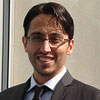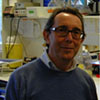Peripheral Nerve
The Blond McIndoe Research Laboratories at Manchester University is the most prominent UK unit working on peripheral nerve injury and regeneration, and uniquely employs scientists and surgeons side by side, allowing this combination of different academic training to explore the scientific and clinical problems examined in various projects.
The main focus of the research is tissue engineering of nerve regeneration, developing an artificial nerve as an alternative clinical approach to nerve reconstruction. This tissue engineering construct can be grafted into an injured nerve bridging the gap and guiding the re-growth of the nerve between the two severed ends. The addition of cultured Schwann cells or stem cells, slow-released growth factors and other molecules within the conduit micro-environment results in improved regeneration and restoration of sensory and motor functions.
Research group members
Dr Adam Reid, MBChB, MRCS, PhD
 Dr Adam Reid is a National Institute for Health Research Clinical Lecturer in Plastic and Reconstructive Surgery. He undertook his PhD on the mechanism of sensory neuroprotection after nerve injury at the University of Manchester under the supervision of Professor Giorgio Terenghi.
Dr Adam Reid is a National Institute for Health Research Clinical Lecturer in Plastic and Reconstructive Surgery. He undertook his PhD on the mechanism of sensory neuroprotection after nerve injury at the University of Manchester under the supervision of Professor Giorgio Terenghi.
He now divides his time between clinical work at the Department of Plastic Surgery at University Hospital of South Manchester and the Blond McIndoe Laboratories, where he is leading research projects on improving nerve regeneration after injury with adipose-derived stem cells and novel bio-engineered conduits.
Dr Alessandro Faroni, MSc, PhD
 Alessandro Faroni is a post-doctoral researcher interested in the development of novel approaches to treat nerve injuries. He is currently focused on the identification of novel medicines to be used in combination with stem cell therapies to improve nerve regeneration. This approach could represent an alternative cure for nerve trauma and other diseases affecting the nervous system.
Alessandro Faroni is a post-doctoral researcher interested in the development of novel approaches to treat nerve injuries. He is currently focused on the identification of novel medicines to be used in combination with stem cell therapies to improve nerve regeneration. This approach could represent an alternative cure for nerve trauma and other diseases affecting the nervous system.
During his PhD, Alessandro has investigated the role of Gamma Aminobutyric Acid Receptors (GABA) receptors in adult stem cells derived from bone marrow and adipose tissue. Adult stem cells can be transdifferentiated in vitro into a glial phenotype and thus used as Schwann Cell substitutes in tissue engineering approaches for peripheral nerve repair.
The presence of functional GABA receptors on differentiated stem cells could open new opportunities for a possible pharmacological modulation of their physiology and phenotype in order to improve their performance in peripheral nerve repair strategies.
In collaboration with Professor Alexei Verkhratsky (Faculty of Life Sciences) at the University of Manchester, Alessandro is now investigating the role of purinergic signalling in the regeneration and re-myelination of the peripheral nervous system.
Dr Atefeh Mobasseri, PhD
 Dr Atefeh Mobasseri is a postdoctoral researcher with a background in biomaterials and the application towards tissue engineering.
Dr Atefeh Mobasseri is a postdoctoral researcher with a background in biomaterials and the application towards tissue engineering.
Her PhD was under the supervision of Professor Sandra Downes (School of Materials) and Professor Giorgio Terenghi at the University of Manchester. Her research is focused on the development of a novel synthetic nerve guidance device to be applied in peripheral nerve regeneration.
Professor Giorgio Terenghi
 Giorgio Terenghi moved to Manchester with his group in 2003, and prior to this he worked as Director and Head of the Nerve Regeneration Group at the Blond McIndoe Research Centre, East Grinstead, Sussex, and at Royal Free Hospital, London. He has published over 200 peer-reviewed papers and 37 invited articles, he is a Fellow of The Royal College of Pathology, and in 2001 he was awarded an Honorary Degree in Medicine from the University of Ume in Sweden, where he is Visiting Professor.
Giorgio Terenghi moved to Manchester with his group in 2003, and prior to this he worked as Director and Head of the Nerve Regeneration Group at the Blond McIndoe Research Centre, East Grinstead, Sussex, and at Royal Free Hospital, London. He has published over 200 peer-reviewed papers and 37 invited articles, he is a Fellow of The Royal College of Pathology, and in 2001 he was awarded an Honorary Degree in Medicine from the University of Ume in Sweden, where he is Visiting Professor.
The main focus is the biological mechanisms of nerve injury and regeneration in peripheral and central nervous systems. The research spans basic science, bioengineering and clinical problems, with particular interest in tissue engineering of nerve conduits to facilitate regeneration over nerve gaps. The different projects integrate the work of scientists and young surgeons allowing this combination of different academic training to explore scientific and clinical problems. The research work combines the use of biomaterials with growth factors and genetically engineered cultured Schwann cells and adult mesenchymal stem cells. The ideal outcome of this research would be to provide answers that can be translated into new surgical treatments for nerve injury.
Since 1995, he has forged an active collaboration with the Department of Hand and Plastic Surgery and the Department of Anatomy at the University of Ume, Sweden where he is Visiting Professor. In particular, with Professor Mikael Wiberg he is investigating ways of promoting neuronal cell survival following acute or chronic nerve injury. In collaboration with Dr Lev Novikov, they are studying the use of cultured Schwann cells and differentiated stem cells for the repair of spinal cord injury. There is an active collaboration with Professor Valerio Magnaghi, University of Milano, investigating GABA receptors in glial and adult stem cells and their role in nerve regeneration.
